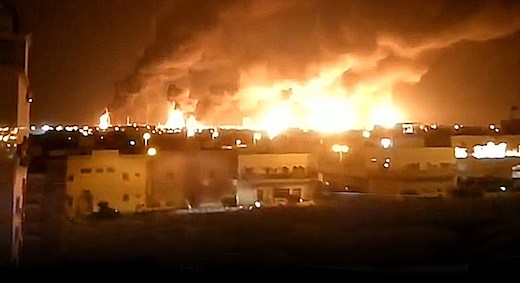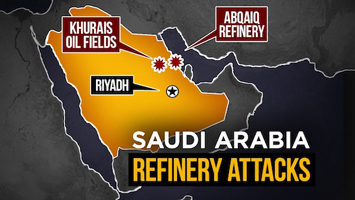Iran denies role in bombing of Saudi oil facilities
By Brian E. Muhammad -Contributing Writer- | Last updated: Sep 18, 2019 - 9:31:46 AMWhat's your opinion on this article?

The United States blamed the Islamic Republic of Iran for a major attack on Saudi Arabia oil facilities that severely crippled production and has worldwide consequences.
It sparked the highest oil price hike in almost 30 years.
President Donald Trump told the media from the White House Sept. 16 it’s “looking like” Iran was responsible but said he doesn’t want war.

America is not looking at retaliatory options until he has “definitive proof” that Iran was responsible, said the president.
The remarks came after Mr. Trump tweeted Sept. 15 that Washington was “locked and loaded” and ready to respond.
“Saudi Arabia oil supply was attacked. There is reason to believe that we know the culprit, are locked and loaded depending on verification,” President Trump tweeted.
In the same tweet, he typed “waiting to hear from the Kingdom as to who they believe was the cause of this attack, and under what terms we would proceed!”
Iranian officials categorically dismissed the accusation, saying Washington has shifted from a failed policy of “maximum pressure” to one of “maximum lying” and “deceit” against the Islamic Republic.
President Hassan Rouhani of Iran said the recent drone attacks on Saudi oil infrastructure were a proportionate Yemeni response to years of daily destruction. “On a daily basis Yemen is being bombarded and innocent civilians are dying … so they have to retaliate,” President Rouhani said.
Iran called on the U.S. to halt the flow of arms to Riyadh as a means of restoring peace in the region.
Media reports said the Houthi rebel groups in neighboring Yemen fighting against an American-supported coalition led by Saudi Arabia claimed responsibility for the attacks. The conflict in Yemen has been raging since 2015 in an attempt to reinstall the country’s Saudi-allied regime and crush the Houthis. Tens of thousands of Yemenis were killed and led to a massive humanitarian crisis.
Col. Turki al-Malki, a Saudi military spokesman told reporters in Riyadh during a Sept. 16 briefing that early investigations showed Iranian weapons were used in the attack. But he also declared the drones were not launched from Yemen and did not provide any more information, according to the Associated Press.
The U.S. released satellite images it claimed showed the source of the attack may have come from either Iraq or Iran.
This crisis comes amid escalating U.S. rhetoric, Iranian counter-rhetoric and growing hostility. Saudi Arabia, U.S. ally, has long been at odds with Iran in a competition for regional influence.
China issued a statement of caution on the question of blame. “Given the absence of a conclusive investigation and result, I think it is irresponsible to determine who should assume responsibility for it,” said Hua Chunying, spokeswoman for China Ministry of Foreign Affairs.
Ms. Hua stated China opposes intensification of conflicts and called on the parties concerned to avoid actions that could escalate regional tensions.
“Trump is in a bind; on the one hand he’s called to action, on the other hand, if he acts, he may very well cause a reprisal, which will take out all of Saudi oil production, which will cause a huge economic crisis in the West,” said E. Michael Jones, editor of Culture Wars magazine in an interview with PressTV.
“If you act, you’re damned if you do, and you’re damned if you don’t,” Mr. Jones said. “At this point, the only thing that Trump can do is negotiate, this will look like backing down, but it’s the only sensible response to the issue,” he added.
Oil is the heart of Saudi Arabia’s economy and a serious disruption of production could have major global consequences. The attack destroyed over half of the Kingdom’s production, and worse wiped out nearly all of its emergency reserves it held in case of a disruption in oil supplies worldwide.
The attack impacted 5.7 million barrels per day of Saudi crude output, which translates to over 5 percent of the world’s supply. The spare oil production capacity it held for emergencies was two million barrels per day.
The Saudis were the major leader in oil because other nations could not afford to drill, tap and maintain the required infrastructure to hold significant amounts of oil idly in reserve.
According to the International Energy Agency, before the attack the Organization of the Petroleum Exporting Countries maintained an emergency global supply of 3.21 million barrels per day.
As for real effects of the disruption in the U.S., there are three emergency stockpiles of petroleum products and 713.5 million barrels of crude oil managed by the Department of Energy’s Office of Petroleum Reserves.
A day after the attack President Trump authorized tapping into the emergency storage. According to the Department of Energy, the U.S. reserve is the largest government-owned stockpile of emergency crude oil worldwide. It was established in the aftermath of the 1973-74 oil embargo that produced crippling gas shortages, long lines, and government rationing of gasoline.
INSIDE STORIES AND REVIEWS
-
-
About Harriett ... and the Negro Hollywood Road Show
By Rabiah Muhammad, Guest Columnist » Full Story -
Skepticism greets Jay-Z, NFL talk of inspiring change
By Bryan 18X Crawford and Richard B. Muhammad The Final Call Newspaper @TheFinalCall » Full Story -
The painful problem of Black girls and suicide
By Charlene Muhammad -National Correspondent- » Full Story -
Exploitation of Innocence - Report: Perceptions, policies hurting Black girls
By Charlene Muhammad -National Correspondent- » Full Story -
Big Ballin: Big ideas fuel a father’s Big Baller Brand and brash business sense
By Bryan Crawford -Contributing Writer- » Full Story






 Click Here Stay Connected!
Click Here Stay Connected!








